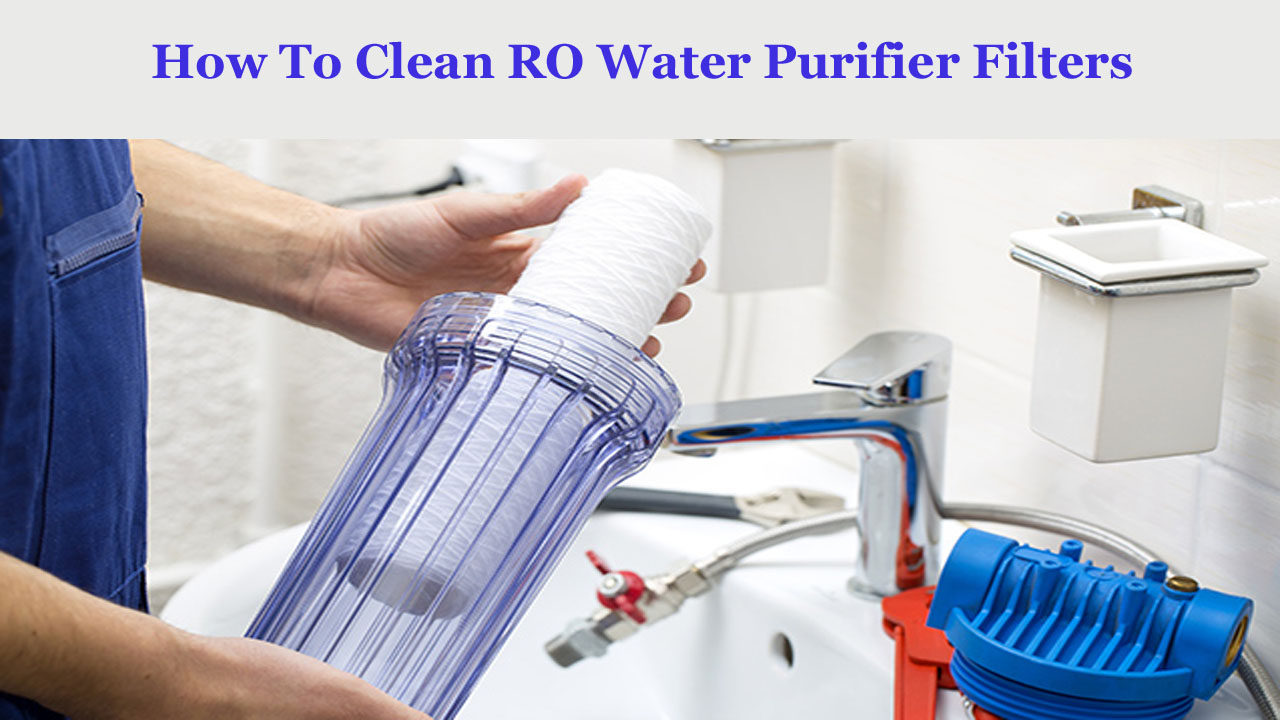What is RO Water Purifier Filters?
RO (Reverse Osmosis) water purifier filters are systematised in water purification systems to eliminate impurities & contaminants from the water. These filters utilize a semi-permeable membrane that permits water molecules to pass through. Eventually, blocks larger molecules like minerals, chemicals, and microorganisms.
Here, as we all know; RO filter is a vivacious component of the water purifier system. Whereas, it can easily remove dissolved salts, heavy metals, and other impurities which are not removed by any other filters. As a result, the RO filter effectively supports improving the taste & quality of drinking water and even helps to protect you from water-borne diseases.
RO water purifier filters naturally consist of pre-filters, sediment filters, carbon filters, and the RO membrane. The pre-filter abolishes large particles, the sediment filter removes smaller particles, & carbon filter removes chlorine and other effective chemicals. The RO membrane helps to remove the additional residual impurities and contaminants, providing clean & safe drinking water.
Before getting into the topic of how we should clean RO Water Purifier filters, let’s ensure the types of Filters in RO water purifiers.
What are the types of filters in RO water purifiers?
There are generally four types of filters that are highly preferable for RO water purifiers:
1. Sediment filter: The first filter in the RO water purifier, which removes large particles, including sand, dust, rust, and silt, from the water.
2. Activated carbon filter: Here, the activated carbon filter removes the chlorine, pesticides, herbicides, and, additionally the other chemicals that can end up in bad odor and taste in the water.
3. Reverse Osmosis (RO) membrane filter: It is the main filter in an RO water purifier, which removes dissolved impurities like heavy metals, salts, and microbes completely from the water.
4. Post carbon filter: This filter is the last filter in the RO water purifier, which further refines the water by removing any residual bad odor or taste & adding some essential minerals back into the water.
Important note: Certain RO water purifiers may have some additional filters, including UV or alkaline filters, in accordance with the model and the brand.
General Cleaning procedure:
• Initially, you’ve to Turn OFF the water supply to the RO system before stepping into the cleaning process of the filters.
• Gently remove the pre-filter, sediment filter, and carbon filter from the RO unit & rinse them with clean water to eliminate loose dirt or debris.
• Later, soak the removed filters in a cleaning solution dissolved in water and a few drops of dishwashing soap or vinegar. On the other hand, you can also use any commercial RO filter cleaner.
• Utilize the soft-bristled brush to gently scrub the filters, paying superior attention to the crevices and corners.
• Mildly, you have to rinse the filters thoroughly using clean water till the soap or cleaning solution has be rushed out.
• Now, use the manual or guide given to replace the filters in the RO unit and safely turn ON the water supply. Operate the system for a few minutes to flush out any left over debris or cleaning solution.
• You must repeat the cleaning process every three to six months or as the manufacturer recommends.
Note: It’s important to trail the manufacturer’s instructions for cleaning & maintenance to safeguard the long-term efficiency of your RO water purifier system.
Sediment Filter cleaning procedure:
Here, we have a list of steps to clean sediment filters in RO:
1. To begin with, turn OFF the water supply to the RO system.
2. Disable the active valve that feeds water into the RO system.
3. Find out the sediment filter housing and turn the filter housing cap to remove the filter cartridge.
4. Keep the required filter cartridge in a bucket or sink.
5. Rinse the sediment filter cartridge with clean water to remove any loose dirt or debris.
6. Then, fill the clean bucket or container with warm water.
7.Now, you need to add few drops of dishwashing soap or a dedicated filter cleaner to the warm water.
8. Gently soak the sediment filter cartridge in the cleaning solution for about 15 minutes.
9. Use the soft-bristled brush or a cloth to gently scrub the sediment filter, paying specific attention to the areas most clogged with sediment.
10. Rinse the sediment filter cartridge systematically with clean water till all the soap and debris are gone.
11. Reinstall the sediment filter cartridge into the housing.
12. Now, let the water supply back on and flush the RO system for 5-10 minutes to clear any remaining dirt or debris.
Note: When it comes to the frequency of cleaning, the sediment filter in RO depends on the water source & the quality of the water. It is recommended to clean the sediment filter every three to six to eight months at least or as the manufacturer suggests.
Activated Carbon/Charcoal Block Cartridges cleaning procedure:
Here, we have a list of steps to clean activated carbon/charcoal block cartridges in an RO water purifier:
1. Switch OFF the water supply to the RO system.
2. Then, find the activated carbon/charcoal block cartridge housing and turn the housing cap to remove the cartridge.
3. Then, safely keep the cartridge in a bucket or sink.
4. Rinse the activated carbon/charcoal block cartridge with clean water to remove any identified loose dirt or debris.
5. Try to fill a clean bucket or container with warm water.
6. Add a few drops of dishwashing soap or a specialized filter cleaner to the warm water.
7. Here, you have to soak the activated carbon/charcoal block cartridge in the cleaning solution for about 15 minutes.
8. Use the soft-bristled brush or a cloth to gently scrub the cartridge, paying particular attention to the areas most clogged with debris.
9. Rinse the cartridge thoroughly with clean water until all the soap and debris are gone.
10. If the cartridge is still dirty or clogged after cleaning, it may want to be replaced.
11. Reinstall the activated carbon/charcoal block cartridge into the housing.
12. Turn the water supply back on and flush the RO system for about 5-10 minutes to clear any remaining dirt or debris.
Modular Filters (i.e., Refrigerator Filters) cleaning procedure:
Here, we have listed steps to clean modular filters such as refrigerator filters:
1. Switch OFF the water supply to the refrigerator.
2. Then, find the modular filter cartridge housing and turn the housing cap to remove the cartridge.
3. Keep the cartridge in a bucket or sink.
4. Rinse the modular filter cartridge with clean water to remove any loose dirt or debris.
5. Fill a clean bucket or container with warm water.
6. Add a few drops of dishwashing soap or a specialized filter cleaner to the warm water.
7. Soak the modular filter cartridge in the cleaning solution for about 15 minutes.
8. Use the soft-bristled brush or a cloth to gently scrub the cartridge, paying particular attention to the areas most clogged with debris.
9. Rinse the cartridge thoroughly with clean water until all the soap and debris are gone.
10. If the cartridge is still dirty or clogged after cleaning, it may need replacement.
11. Reinstall the modular filter cartridge into the housing.
12. Enable the water supply back on and run the water through the filter for about 5 minutes to clear any remaining dirt or debris.
Reverse Osmosis Filter Elements cleaning procedure:
Here are the steps to clean Reverse Osmosis filter elements in an RO water purifier:
1. Switch OFF the water supply to the RO system.
2. Try to disable the valve that feeds water into the RO system.
3. Locate the RO filter housing and turn the housing cap to remove the filter elements.
4. Keep the filter elements in a bucket or sink.
5. Fill a clean bucket or container with warm water.
6. Add a few drops of dishwashing soap or a specialised RO filter cleaner to the warm water.
7. Soak the filter elements in the cleaning solution for about 15 minutes.
8. Utilise a soft-bristled brush or a cloth to gently scrub the filter elements, paying specific attention to the areas that are most clogged with debris.
9. Rinse the filter elements thoroughly with clean water until all the soap and debris are completely washed off.
10. If the filter elements are yet dirty or clogged after cleaning, it’s time to replace them.
11. Reinstall the filter elements into the housing.
12. Turn the water supply back on and flush the RO system for 5-10 minutes to clear any dirt or debris.
Why does the RO Water Purifier Filter get dirt, and how often should it be cleaned?
RO water purifier filters get dirty due to the accumulation of contaminants like sediment, chlorine, & bacteria, such other particles. These contaminants are filtered out of the water and get stuck in the filter, ultimately clogging it and decreasing effectiveness.
The frequency of cleaning your RO water purifier filter rest on numerous factors, including:
1. Quality of the incoming water
2. Amount of water consumed
3. Type of filter used.
Tip: It is highly recommended to clean the pre-filter, sediment filter, and carbon filter every 3-6 months, while the RO membrane should be replaced every 1-2 years. Though, it would help if you always trailed the manufacturer’s recommendations for your detailed system to make sure ideal performance and longevity. Consistent maintenance of your RO water purifier system can benefit expand its lifespan and ensure the quality of your drinking water.
Why should we need to clean RO Water Purifier Filter?
RO (Reverse Osmosis) Water Purifier filters are a significant component of the water purification system. These filters remove impurities and contaminants from the water, fetching to get clean and safe drinking water. However, over time, the filters can become clogged with debris, dirt, and other contaminants, dropping their efficiency and end-up in poor water quality.
Conclusion:
Hence, cleaning the RO water purifier filter regularly is vital to preserve its efficiency and prolong its lifespan. This aids in safeguarding that the purified water produced by the system remains safe & clean to drink. Poor filter maintenance can also lead to bacterial growth, which can cause odours and affect the taste of the water. Therefore, cleaning the RO water purifier filter helps preserve the water quality and prolong the life of the water purifier system.

